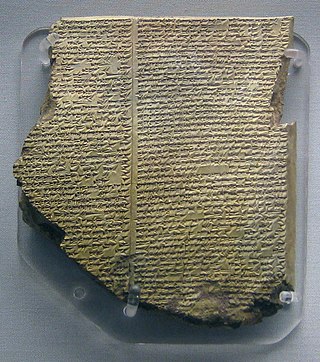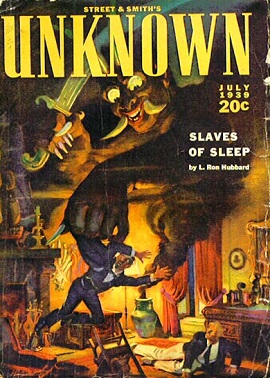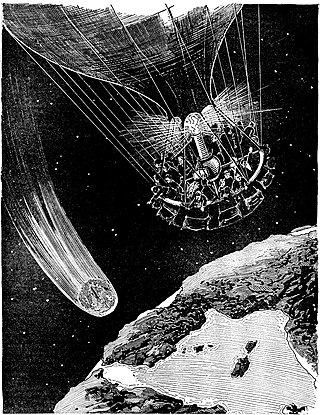
Science fiction is a genre of speculative fiction, which typically deals with imaginative and futuristic concepts such as advanced science and technology, space exploration, time travel, parallel universes, and extraterrestrial life. It is related to fantasy, horror, and superhero fiction and contains many subgenres. Its exact definition has long been disputed among authors, critics, scholars, and readers.

Glen David Brin is an American science fiction author. He has won the Hugo, Locus, Campbell and Nebula Awards. His novel The Postman was adapted into a 1997 feature film starring Kevin Costner.
The timestream or time stream is a metaphorical conception of time as a stream, a flowing body of water. In Brave New Words: The Oxford Dictionary of Science Fiction, the term is more narrowly defined as: "the series of all events from past to future, especially when conceived of as one of many such series". Timestream is the normal passage or flow of time and its historical developments, within a given dimension of reality. The concept of the time stream, and the ability to travel within and around it, are the fundamentals of a genre of science fiction.

Mind uploading—transferring an individual's personality to a computer—appears in several works of fiction. It is distinct from the concept of transferring a consciousness from one human body to another. It is sometimes applied to a single person and other times to an entire society. Recurring themes in these stories include whether the computerized mind is truly conscious, and if so, whether identity is preserved. It is a common feature of the cyberpunk subgenre, sometimes taking the form of digital immortality.

Robert Paul Holdstock was an English novelist and author best known for his works of Celtic, Nordic, Gothic and Pictish fantasy literature, predominantly in the fantasy subgenre of mythic fiction.

Phyllis Eisenstein was an American author of science fiction and fantasy short stories as well as novels. Her work was nominated for both the Hugo Award and Nebula Award.
Elizabeth A. Lynn is an American writer most known for fantasy and to a lesser extent science fiction. She is particularly known for being one of the first writers in science fiction or fantasy to introduce gay and lesbian characters; in honor of Lynn, the widely known California and New York–based chain of LGBT bookstores A Different Light took its name from her novel. She is a recipient of the World Fantasy Award—Novel.

Witch House is a fantasy novel by American writer Evangeline Walton. It was published in 1945 by Arkham House in an edition of 3,000 copies. It was the first full-length novel to be published by Arkham House and was listed as the initial book in the Library of Arkham House Novels of Fantasy and Terror. An expanded version, with a newly written 20,000-word prologue, was published in England in 1950. In 2013, Centipede Press issued the first American edition of this revised version, also including previously unpublished writings by Walton and several of her short stories.

The Mind Parasites is a science fiction horror novel by English author Colin Wilson. It was published by Arkham House in 1967 in an edition of 3,045 copies. It was Wilson's first and only book published by Arkham House.

Earthman's Burden is a collection of science fiction stories by American writers Poul Anderson and Gordon R. Dickson. It was first published by Gnome Press in 1957. The stories involve a teddy bear-like alien race known as Hokas, and spoof a variety of fictional genres.

Immortality is a common theme in fiction. The concept has been depicted since the Epic of Gilgamesh, the oldest known work of fiction. Originally appearing in the domain of mythology, it has later become a recurring element in the genres of horror, science fiction, and fantasy. For most of literary history, the dominant perspective has been that the desire for immortality is misguided, albeit strong; among the posited drawbacks are ennui, loneliness, and social stagnation. This view was challenged in the 20th century by writers such as George Bernard Shaw and Roger Zelazny. Immortality is commonly obtained either from supernatural entities or objects such as the Fountain of Youth or through biological or technological means such as brain transplants.
Everett B. Cole (1910-2001) was an American writer of science fiction short stories and a professional soldier. He fought at Omaha Beach during World War II and worked as a signal maintenance and property officer at Fort Douglas, Utah, retiring in 1960. He got a bachelor's degree in Math and Physics and became a Math, Physics, and Chemistry teacher at Yorktown High School in Texas. His first science fiction story, "Philosophical Corps" was published in the magazine Astounding in 1951. His fix-up of that story and two others, The Philosophical Corps, was published by Gnome Press in 1962. A second novel, The Best Made Plans, was serialized in Astounding in 1959, but never published in book form. He also co-authored historical books about the south Texas region.

The Legion of Time is a collection of two science fiction novels by the American writer Jack Williamson. It was first published by Fantasy Press in 1952 in an edition of 4,604 copies. The novels were originally serialized in the magazines Astounding Science Fiction and Marvel Stories.

The Blind Spot is a science fiction novel by American writers Austin Hall and Homer Eon Flint. The novel was originally serialized in six parts in the magazine Argosy beginning in May 1921. It was first published in book form in 1951 by Prime Press in an edition of 74,200 copies, though fewer than 800 were actually bound, and the remainder are assumed lost. The sequel, The Spot of Life, was written by Hall alone.

Slaves of Sleep is a science fantasy novel by American writer L. Ron Hubbard. It was first published in book form in 1948 by Shasta Publishers; the novel originally appeared in a July 1939 issue of pulp fantasy fiction magazine Unknown. The novel presents a story in which a man travels to a parallel universe ruled by Ifrits. The protagonist takes on the identity of a human in this dimension, and becomes involved in the politics of Ifrits in this fictional "Arabian Nights" world.

The World Below is a science fiction novel by British writer S. Fowler Wright. It was first published in 1929 by Collins. The novel was originally intended as a trilogy, but the third part was never written. The first part was originally published separately as The Amphibians by Merton Press in 1924. The second part was published separately by Galaxy Science Fiction Novels in 1951 and was also titled The Worlds Below.

Drome is a fantasy novel written and illustrated by John Martin Leahy. Originally serialized in the magazine Weird Tales in five parts beginning January 1927, it was first published in book form in 1952 by Fantasy Publishing Company, Inc. in an edition of 1,000 copies.

The Revenge of Dracula is a horror novel by British writer Peter Tremayne. It was first published in the United Kingdom in 1978 by Bailey Brothers & Swinfen. The first United States edition was published by Donald M. Grant, Publisher, Inc. in 1978 in an edition of 1,250 copies which were signed by the author and the illustrator, Dan Green. It is the second book in Tremayne's Dracula Lives trilogy.

Comets have appeared in works of fiction since at least the 1830s. They primarily appear in science fiction as literal objects, but also make occasional symbolical appearances in other genres. In keeping with their traditional cultural associations as omens, they often threaten destruction to Earth. This commonly comes in the form of looming impact events, and occasionally through more novel means such as affecting Earth's atmosphere in different ways. In other stories, humans seek out and visit comets for purposes of research or resource extraction. Comets are inhabited by various forms of life ranging from microbes to vampires in different depictions, and are themselves living beings in some stories.

Fantasy is a genre of fiction involving magical elements, as well as a work in this genre.

















